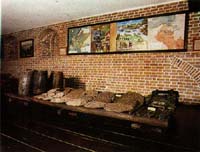PrefaceThis is a merchant ship from ca 1390-1430 loaded with copper. Sunk off Danzig, present Gdansk, found in 1969 and excavated 1971-75 by the Polish Maritime Museum. It is listed as Polish wreck number W-5. The ship is clinker-built and may have been a holk rather than a cog. Per Åkesson Barrels, copper, iron bars, staves etc from the wreck. Gdansk Copper WreckThe Copper Wreck dates to the 14th century, and was between 40 - 60 years old at the time of sinking, according to dendrochronological dates. It had a cargo of copper ingots, hence the name, and wax and pitch. It was possibly on fire when it sank, as the frames and strakes were covered in a goo of melted wax and pitch. The hull itself survives in three sections: the starboard stern section from keel to waterline; the keel, bits of keelson and frames. This allows for some conclusions of the way it was built. The ship is shell-built, with the frames being fitted in later. The keel is 16.34m long, the garboard strake fitted to it with treenails at the bow and iron nails at the stern. The keel terminates in a two-step rabbet onto which a double sternpost was fitted. A likewise construction can be seen in the Bremen cog, which also sports a double sternpost fitted in this way. The stern post is rabbeted to receive the strakes, similar to Viking stern posts. The strakes were of oak and had luting of animal hair between the clinker clench. Almost all the strakes had a groove into which the luting could be laid. The frames were scarfed together, and quite heavy. A very similar boat to the Copper Wreck is the Aber Wrac'h 1. It has a flexible shell-built planking but a rigid framing inside. All framing was fastened to each other only by the nails that held them to the hull. especially in the planking, framing and the crossbeams the two ships resemble each other. They have features of the cog, but are derivatives of the Nordic type. Also to be noted is the way that the cargo was packed in the hull. There was a ceiling of oak planks, over which casks of iron and bundles iron bars had been laid. The iron bars were bundled together with copper strips and string. They were laying in the stern area, while a load of circular copper ingots lay amidships. All the metal had been wedged fast with wooden wedges, so it would not slip about. On top of the metal had been bundled the casks of pitch, birch tar, wood ash and resin and wax. Margret Sloan BibliographyLitwin J., International Journal of Nautical Archaeology, 9.3 1980: pp 217-226 |

 Back to Nordic Underwater Archaeology
Back to Nordic Underwater Archaeology